25 The Great War, Part I
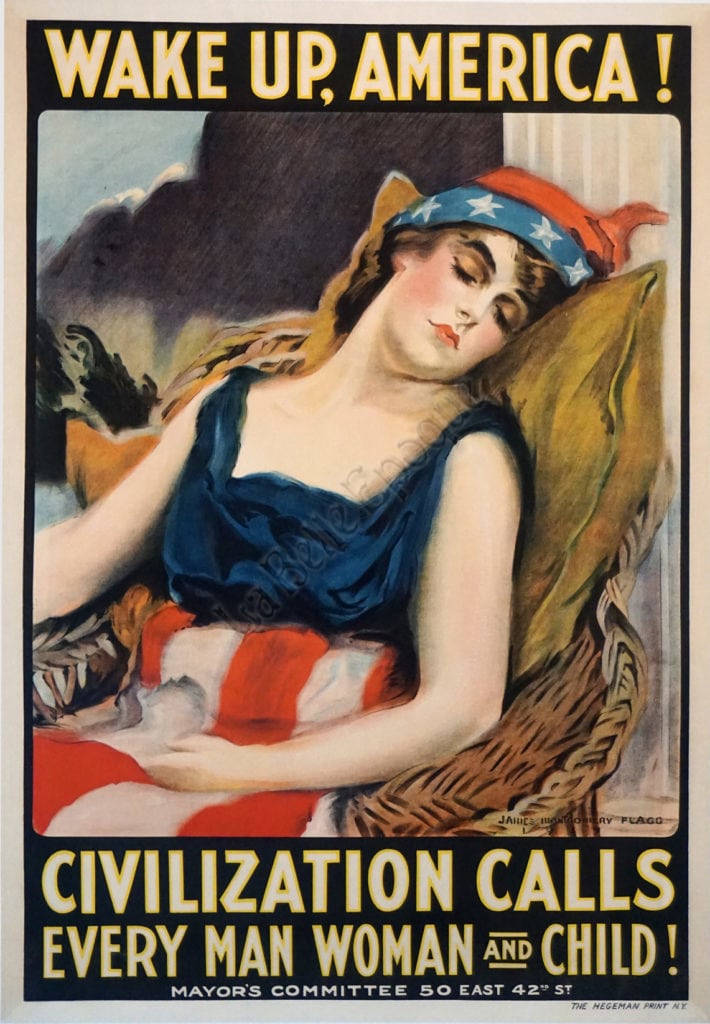
Eugene Bullard, the “Black Swallow of Death”
Eugene Bullard[1] was born in Columbus, Georgia in 1895 to a Creek Indian mother and an African American father. He grew up in a racially divided and openly antagonistic period of US history. But, he had heard that race did not matter to the people of France.
He stole away on the Marta Russ, a German freighter ship. In 1913, at the age of 18 or 19, he arrived in Paris. For several months he took odd jobs to include taking a jab at boxing in his newly-adopted country until the Guns of August interrupted the lives of Eugene Bullard and tens of millions of other Europeans. Hearing the call to defend his newly adopted country, Bullard joined the French Foreign Legion on his nineteenth birthday and very quickly saw action against German forces. Bullard was not the only American fighting for France: over 500 white Americans joined the French military and maybe a dozen Blacks, to include another African American boxer, Bob Scalon.
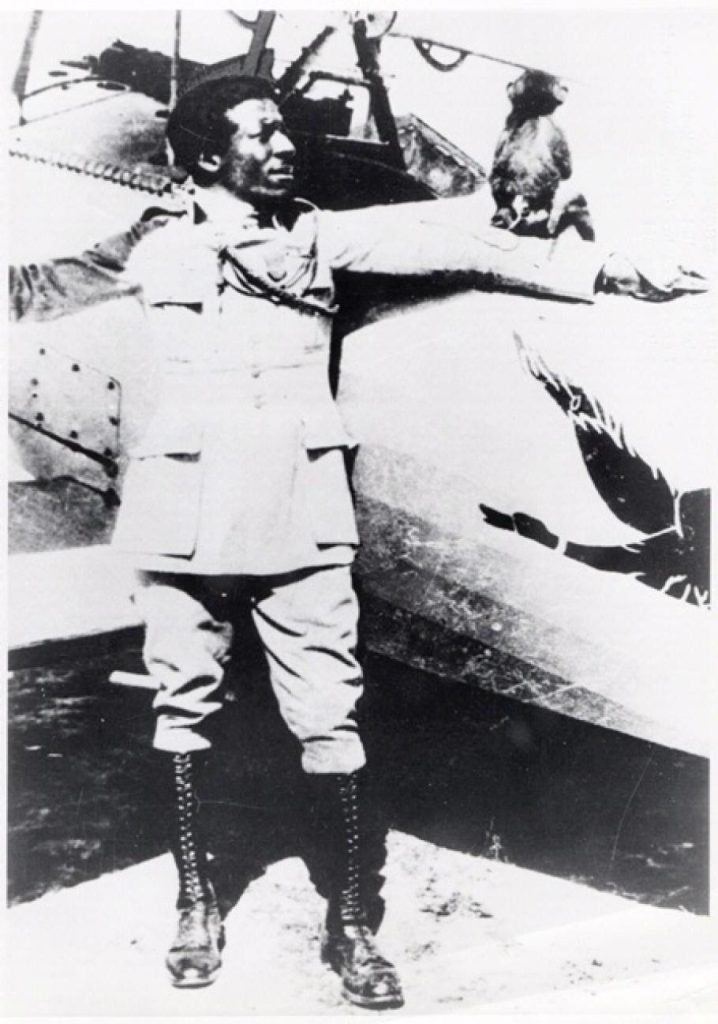
Bullard fought with a tenacity of purpose. Regardless if it was with a machine gun or hand-to-hand combat with bayonets, Bullard’s bravery and fighting spirit were legendary throughout the French military. The Battle of Artois was, like so many battles of the Great War, horrific in the sheer amount of loss of life. Bullard’s unit, which consisted of over 4,000 men, was cut to pieces. Only about 27% of his unit survived that battle unscathed. Bullard saw further action in Champagne and Verdun. Verdun was particularly horrific. With tens upon tens of thousands of people slaughtered by the new German “Big Bertha” artillery guns, some described the carnage resembling a “Chicago slaughterhouse” as pieces of humans lay all around, blown into trees, and ground into the very soil.
A piece of German shrapnel at Verdun killed four of Bullard’s comrades, blew all but four teeth out of Bullard’s mouth, shattered one of his legs, and ultimately ended his career as an infantryman. As he recovered, Bullard found out that he was to be awarded France’s highest military honor for bravery: the Croix de Guerre.
While Eugene Bullard fought for and in France years before the United States would join the warring parties, Americans back home listened to racially charged music such as the 1917 hit by Earl Fuller’s Famous Jazz Band entitled A Coon Band Contest, or pre-war favorites such as A Cyclone in Dark Town (Arthur Pryors Band, 1911), The Whistling Coon (Bill Murray, 1911), and Mammy’s Shufflin’ Dance (The American Quartet, 1912). Needless to say, American popular culture during the first two decades of the twentieth century was not sympathetic to race relations.
While recuperating in a French field hospital, William Irwin, an American reporter for the Saturday Evening Post first introduced Americans to Bullard, with a back-hand compliment, referring to him as a “black Hercules … not at all like the Negro we knew at home.”[2]
Bullard’s injuries made him unfit for the infantry, but you did not need two perfectly fine legs to fly an airplane and thus he entered a French flight school in October of 1916 (African Americans will not be allowed to enroll in American flight schools until well after the Great War). Seven months later he was a full-fledged pilot and was assigned to the American flight group, Lafayette Escadrille, which at that time operated under French command as the United States would not officially join the war until April of 1918.
Bullard flew with a Rhesus monkey as a co-pilot. He purchased the monkey in Paris and named him “Jimmie.” Bullard’s nickname was the Black Swallow of Death. His insignia, visible on the fuselage, was a red heart with a knife through it and the words, “Tout le Sang qui coule est rouge!” – “All blood runs red.” He even shot down a German plane in his very first dogfight and his skills as an aviator were legendary. With at least 78 bullet holes in his aircraft, Bullard successfully landed from his first dogfight, got the plan fixed, and immediately went back to the front. Bullard flew in at least twenty combat missions.
By the time the war came to an end, Bullard has received every medal that France could bestow on their military heroes. He was embraced by Charles de Gaulle, the famous World War II-era French resistance leader and future president of France. Bullard’s exploits were wildly publicized in French newspapers but sadly there is no evidence that any mainstream American newspaper reported on this war hero. One short reference to Bullard’s career as an infantryman appeared in the National Association for the Advancement of Colored People’s (NAACP) publication The Crisis in January of 1918.
Although Bullard experienced professional opportunities and enjoyed a lifestyle that certainly was not equaled by most African Americans, France was not a racially perfect society. With one year left in the war, the French military suddenly ordered the removal of Bullard from the aviation corps and placed back in an all-black infantry unit. This turn in Bullard’s career was orchestrated by a white American doctor named Edmund Gros. Gros did not support the use of blacks in any American aviation capacity, to include ground crew. Although Bullard passed his required physical, to be a pilot meant that you had to be an officer or be eligible to become an officer and Bullard’s rank was Sergeant and he lacked the required education to become an officer.
Ironically, Bullard escaped the US in search of racial equality and when he found it, the US found him and stripped him of his status as an equal, even during a time of war. Bullard was transferred to a remote mountain military camp, approximately 300 miles south of Paris.
When the war came to a close, Bullard reappeared on the streets of Paris. He was frequently attacked, verbally and physically, by white American military officers. He tried to avoid the hotels, restaurants, and bars that were frequented by American servicemen because those French public spots tended to follow the Jim Crow laws and attitudes of the United States. Bullard fraternized with French troops and French (white) women. US intelligence kept one eye on Bullard and even tried to have him deported back to his birth home when the US government feared that Bullard might become a French citizen and thus could become a beacon of hope for other African Americans. Bullard remained in France, sometimes traveling to French or English colonial ports of call as part of a Franco-American jazz band or even to compete in boxing matches. He married a French woman and the couple had three children. The Bullards owned their own Parisian nightclub where they employed the famous American singer Josephine Baker and a young wanna-be-poet named Langston Hughes as a dishwasher and cook. Bullard lived the life of what you might call middle-to-upper class. But when the Germans returned in 1940 Bullard fled back to his native country.
Bullard faded into history and certainly felt the slings and arrows of racial segregation in the US during the post World War II era. In 1959 France knighted Bullard for his bravery, valor, and service to the country during World War I. White newspapers refused to cover the event. Bullard was identified by a news reporter for NBC and was given a brief appearance on the Today Show in December of 1959 to talk about his war experiences. Bullard died in New York City in 1961. Lying in New York’s Metropolitan Hospital, he reportedly seized a friend’s hand and gasped, “It’s beautiful over there.” Then he died. France was indeed a mythical place for Eugene Bullard. Unlike the United States between 1912 and 1922, France lacked the levels of racial violence, racial bias, and racially-based laws and customs. This chapter examines how we got involved in the war, why we got involved in the war, and how the war altered, seemingly temporarily, American ideas on liberty at home and our place in the world while Americans continue to wrestle with the idea that “all men are created equal.”[3]
The World as it Should Be – Wilsonian Diplomacy
There is a tendency among historians to contrast the diplomatic philosophy of Franklin Delano Roosevelt (US president during World War II) and Woodrow Wilson (US president during World War I). Roosevelt was a realist. He saw the world as it was, not as he wished it to be. He was perfectly willing to support Latin American dictators provided that those dictators also supported the United States. Wilson, however, was an idealist. He saw the world as it should be, not as it was. He believed the US had a special destiny to spread democracy, capitalism, and American religious tenets all over the globe. For Wilson, foreign policy was missionary work.
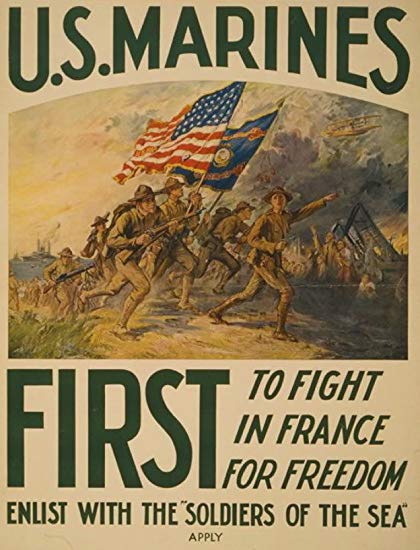
There were five essential aspects of Wilson’s foreign policy philosophy. First, Wilson generally upheld the idea that people should be ultimately responsible for creating and maintaining the governments of their choosing, or the right of every nation of self-determination as he called it. Second, Wilson believed that people’s rights, liberties, and freedoms were best guaranteed when promulgated in written constitutions. Third, Wilson was a proponent of capitalism. Fourth, Wilson believed in universal disarmament. Without a prevalence of weapons, the chance of future wars would dwindle, he believed. Finally, Wilson saw the US as a redeemer nation: the US was mandated by God to spread American blessings throughout the whole world. Initially Wilson believed this particular US role could best be accomplished by the United States remaining neutral after the war in Europe began. However, as will be seen, by the early spring of 1917, Wilson had changed his mind, believing that the US can only help fix the world’s ills by joining the crusade to make the Great War “the war to end all wars.” Interestingly, prior to the outbreak of war in Europe in the summer of 1914, Wilsonian idealism was tested repeatedly in the nation’s own backyard.
Woodrow Wilson, not unlike his predecessors, was intimately more involved in Latin America than any other part of the world. Wilson’s intervention in the affairs of many Latin American nations was disingenuous and hypocritical; prior to becoming president, Wilson was highly critical of Theodore Roosevelt’s heavy-handed imperialism and interventionist policies in the Western Hemisphere and pledged he would eschew such an approach. Within months of his inauguration, he sent Marines into Nicaragua, ostensibly to protect American interests. Such a move reflected a policy no different than Taft’s Dollar Diplomacy or TR’s interventionist pursuits. In fact, Wilson invoked the Roosevelt Corollary to justify US occupation of Nicaragua. The Marines remained in Nicaragua until President Franklin Roosevelt ordered their removal in 1933. Wilson sent William Jennings Bryan to negotiate a treaty with that nation’s most powerful controlling family, Chamorro, led by General (and future dictator) Emiliano Chamorro. The Bryan-Chamorro Treaty gave the US sole right to build and maintain a canal through Nicaragua. The US Senate passed the Nicaraguan Canal Treaty in 1916. It appeared that when it came to canal building Wilson wanted to leave a legacy equal to that of his rival TR.
Wilson sent the US Marines into Haiti in 1915 and the following year into the Dominican Republic. In both instances, Wilson’s believed the Marines were necessary to bring stability to the hemisphere by ending the civil wars and endemic violence that seemed to plague both of those countries. Naturally Wilson hoped that with US “help” both Haiti and the Dominican Republic would be transformed into pro-US democratic and capitalistic national governments. The US failed in both instances. Haitians and Dominicans until recently lived under corrupt and brutally oppressive dictatorships and consequently suffered through constant civil war. The U.S. rarely succeeded in creating democratic, capitalistic, pro-US regimes as a result of military intervention (As will be seen in a later chapter, post-World War Japan and Germany proved to be the exceptions).
Throughout most of its history the United States traditionally expanded its frontiers and spread its political and economic values through the acquisition of territory by purchase or peaceful negotiation: the Louisiana Purchase (1803); Florida (1819), the Oregon country (1846), southern Arizona and New Mexico—the Gadsden Purchase (1853), Alaska (1867), and Guam (1899), to name a few. Thus in 1917 Wilson, with the consent of Congress, purchased the Virgin Islands from Denmark.
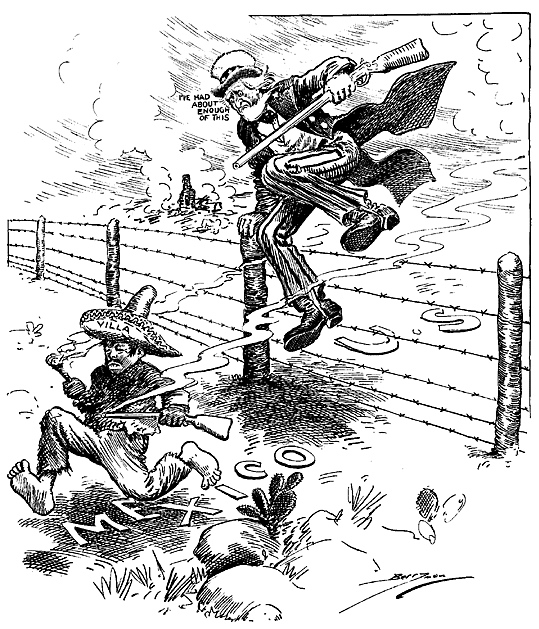
Closer to home, and much more problematic for Wilson, was the issue of the Mexican Revolution, which erupted in 1910 when lawfully elected presidential candidate Francisco Madero triumphed at the polls over one of Mexico’s longest-standing dictators, Porfirio Diaz. Although Diaz had agreed to the election and had promised to step down if defeated, he reneged, largely because he succumbed to foreign capitalist pressure led by the United States to remain in power. Foreign investors were weary of Madero, who had pledged during the campaign that he would nationalize all foreign-owned enterprises, which by 1910, controlled most if not all of Mexico’s most important industries—railroads, telegraph, telephone, mining, and oil. Foreigners also controlled either directly or indirectly the bulk of Mexico’s land. For example, American newspaper magnate, William Randolph Hearst, owned ten million acres in the northern state of Chihuahua. As a result Diaz’s close ties with foreign capitalists, if Madero wanted to become Mexico’s president, he unfortunately had to take office by force. Thus began the military aspect of the Mexican Revolution, a ten-year-long bloodbath in which thousands of Mexicans died or fled across the Rio Grande to the United States for safety.
Rallying to Madero were other anti-Diaz and anti-gringo leaders, whose names have become legendary on both sides of the Rio Grande: Pancho Villa, Emiliano Zapata, Alvaro Obregon, Plutarco Calles, and Venustiano Carranza. Although many of these caudillos joined with Madero for personal reasons and frequently engaged in outright banditry and murder in “the name of the Revolution,” they nonetheless were united in their cause to drive both Diaz, who they regarded as a gringo lackey, and all foreigners out of Mexico. In 1911, Madero, with the help of such individuals, defeated Diaz’s forces and the former president fled to Cuba and eventually to Spain, where he lived the remainder of his life.
However, no sooner did Madero take office than counter-revolutionary, right-wing military leaders in collusion with foreign capitalists conspired to overthrow his government. In 1913 General Victoriano Huerta succeeded in toppling via a coup d’etat, the Madero regime. Madero was held prisoner for a few days then along with his entire family and cabinet, brutally executed by Huerta henchmen. Madero’s murder had the full-fledged support of the foreign capitalists and their respective legations. With Huerta in power the European and American businesses could now continue their exploitation of Mexico’s resources and industries and its people for their own private profit. Despite the backing of United States and European capitalists, Huerta could not quell the fires of revolution. Villa, Zapata, and the other pro-Madero chieftains formed uneasy alliances to overthrow the Huerta regime.
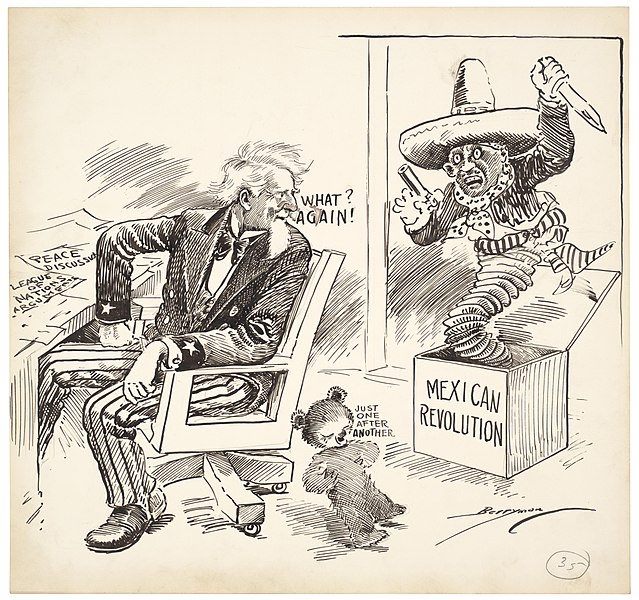
The US had been less than dedicated to their support of any one Mexican official and to make matters more nebulous, some Mexican leaders were fighting against the old regime in Mexico as well as US corporate interests in Mexico. For example, a man named Francisco Villa was initially supported by the United States, until a more “democratic” fellow named Venustiano Carranza won the fancy of President Wilson. Wilson’s support for Carranza resulted in Villa launching attacks against US interests on the Mexican side of the US-Mexican border, until the fall of 1916 when Villa raided the New Mexican town of Columbus, killing at least twenty Americans in the process and resulting in Wilson ordering the US Army to invade Mexico.
Under the leadership of General John “Blackjack” Pershing, the US military force included many elements of National Guards from Texas, New Mexico, and Arizona. Pershing’s task was to locate and arrest Villa. Not only did Pershing fail to capture Villa, but American and Mexican forces clashed resulting on the deaths of both American and Mexican troops. Wilson will order Pershing out of Mexico in early 1917 in order to prepare the US for its participation in the war to end all wars.
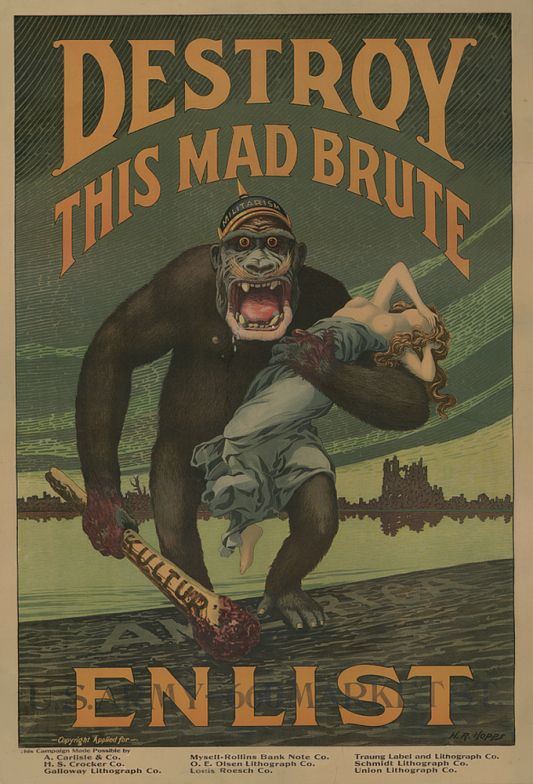
Causes for the Great War
Some of the long-range causes of the war include militarism, nationalism, and secret alliances. Many European powers had been developing new weapons such as machine guns and the airplane. Although national borders such as Russia, Austria, and France were clearly delineated by 1914, ethno-linguistic ties transcended seemingly artificial national borders. For example, many French citizens living in the Alsace-Lorraine region of western France spoke German and some smaller areas of the Austrian Empire had religious and language ties to Russia, such as the Serbs. Finally, what made this war different was the long list of countries who promised to mobilize their forces in support of other countries in times of international duress. For example, England had an agreement with France in which England would mobilize its forces if Germany ever threatened France and Russia had pledged to support (militarily if necessary) the Slavic-speaking, Orthodox-praying Christians living among Muslims in the southern tip of the Austria-Hungarian Empire.
The immediate cause of the war was the assassination of the Austrian Arch Duke Franz Ferdinand (the number two man in Austria) at the hands of Russian-leaning separatists in Serbia. Austria demanded that Serb officials hand over the assassins. When they failed to do so, Austria threatened to invade. That threat prompted Germany to mobilize its forces. Germany had an agreement with Austria that the former would mobilize to protect the latter’s eastern flank fearing Russia might come to the aid of the Serbs.
Diplomacy failed and war came, again, to Europeans in the summer of 1914. Unlike previous wars, this one proved to be horrific in the sheer number of causalities. For example, the First Battle of the Marne (September 1914) resulted in over 500,000 casualties among German, French, and British forces. Europe will eventually lose an entire generation of men before the guns fall silent on the eleventh hour, of the eleventh day, of the eleventh month of 1918.
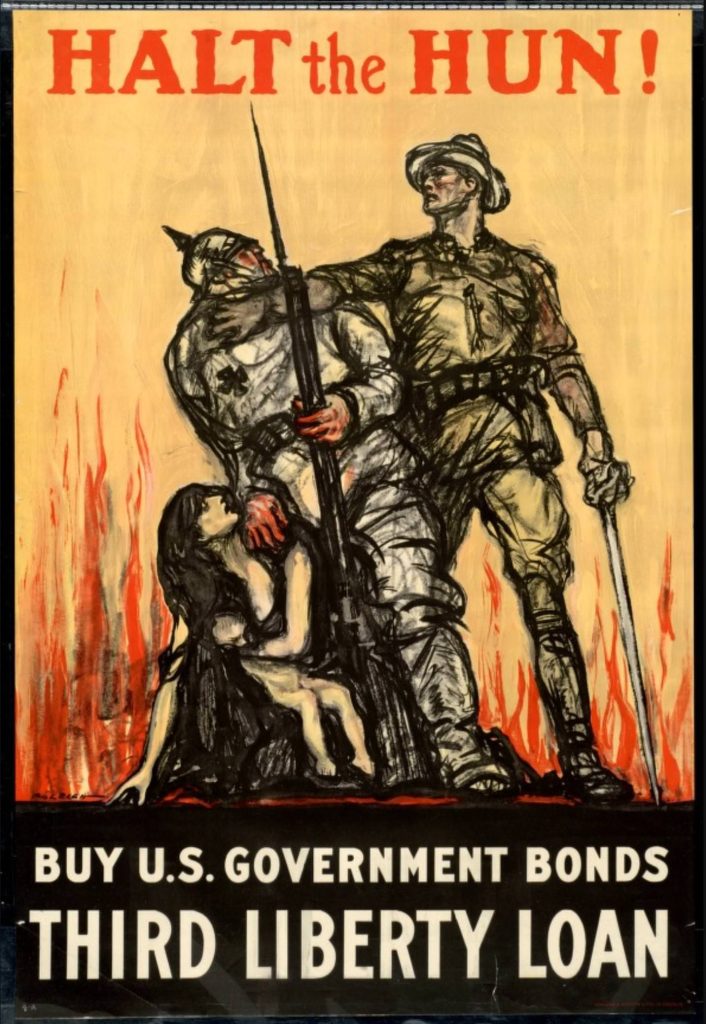
Wilsonian Neutrality
Wilson asked Americans to be extreme and impartial in their neutrality. He asked Americans to be impartial in thought, word, and action. His reasons for this extreme impartiality were many. First, Wilson was concerned about how a protracted European conflict would affect the American economy. Second, there was a pervasive fear towards German immigrants. Wisconsin, Illinois, Michigan, Minnesota, and South and North Dakota saw massive increases in their German populations following the decades after the Civil War. Some wondered if those immigrants would support their newly-adopted land or their motherland. Third, why should the US pick a side? There was no reason to believe that this war would be any different from the other European conflicts that the US did not participate such as the Balkan War, Franco-Prussian War, or the Crimean War.
Finally, Woodrow Wilson dreamed about creating what he called the “New World Order.” Only be remaining neutral would the US be in the best position (economically, militarily, politically, and diplomatically) to remake the world following fourteen simple ideas. Called his “Fourteen Points Address,” Wilson announced very specific American war aims in January of 1917 only after he failed to get England and France to issue their own vision for the world.
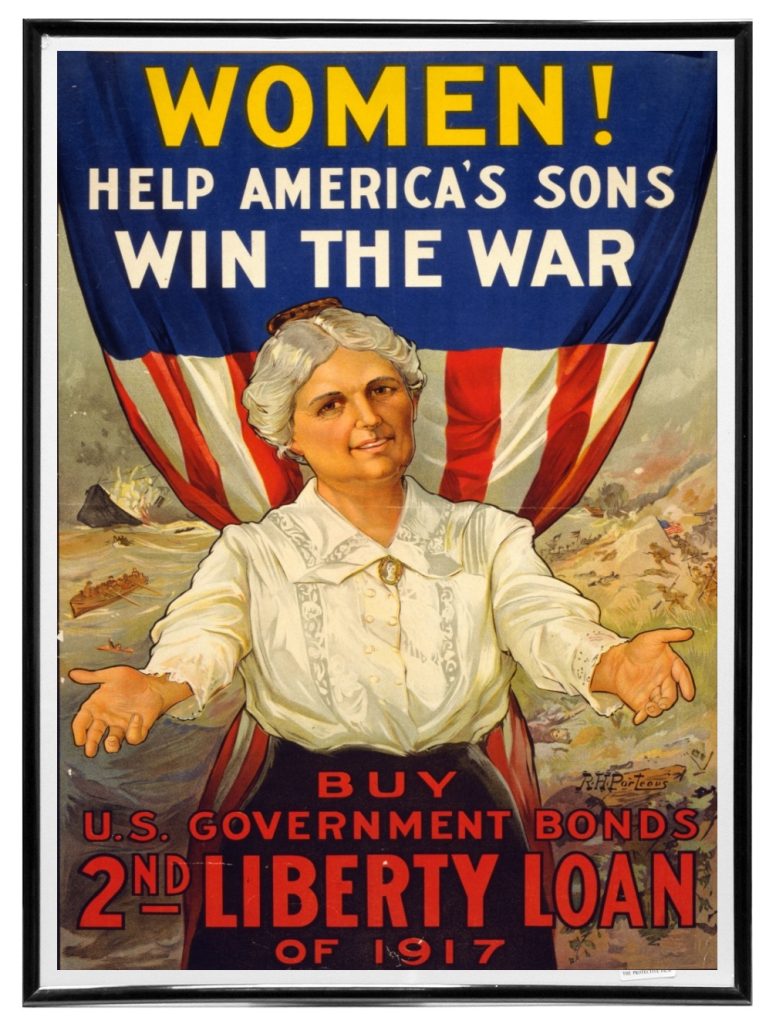
The Unmanly Business of Submarine Warfare
Wilson will inevitably use German submarine warfare, to which he called a “cruel and unmanly business,” as one of his justifications for going to war although that pretext will be based on the idea of neutral rights. Challenges to American neutrality came predominantly from England. The Royal Navy threw up an undeclared blockade and mined the North Sea. Both of these actions flew in the face of international agreements, such as the 1899 and 1907 Hague Conventions. In addition, England armed merchant ships, which was strictly prohibited by international covenants. England stopped US ships and confiscated US property that appeared on England’s list of items that they would not allow to be sold or traded during war. England blacklisted American companies that traded with neutral countries suspected of trading with Germany or its allies. England routinely stopped US mail ships, confiscated letters and packages, opened the US mail, and then censured or destroyed what England decided was counter to their war efforts.
After numerous English violations of international agreements, Germany declared that they would alter their tactics to include firing on suspected merchant ships that were armed or English ships trying to evade attack by flying the flags of neutral countries. Ultimately, Germany warned all ships flying neutral flags to stay away from English waters. In August of 1915 a German U-boat attacked a British ship and when a nearby merchant ship (Arabic) flying the English flag came to rescue the survivors, that ship too was torpedoed. The dead included two Americans. The German government was quick to apologize and promised the US to never fire on merchant ships without offering sufficient warnings and only after securing the safety of non-combatants. In 1916 German officials authorized its naval commanders to attack armed merchant ships, but not passenger ships. A French passenger ferry, the Sussex, was torpedoed by a German U-boat, resulting in the deaths of many French, but no American, citizens. Wilson once again waged his diplomatic finger in the face of Germany demanding that they cease these attacks. Germany, probably fearing that the US might enter the war after all, declared that they will no longer attack any civilian ship without first securing the safety of its non-combatants. This was known as the Sussex Pledge.
Interestingly enough, these attacks, promises, threats, and pledges all followed on the heels of the greatest loss of civilian life on the high seas. In the early spring of 1915, carrying nearly 2,000 passengers from the US to England, the British luxury liner Lusitania was hit by a single torpedo from a German submarine. The ship sunk in less than ten minutes and with the loss of nearly 1200 of its passengers, including many Americans. The German government tried to warn Americans by taking out advertising in dozens of US newspapers:
American businessmen, possibly in cooperation with the Wilson administration, did indeed place arms, explosives, and other forms of ammunition aboard the Lusitania, which was a clear violation of the separation of civilian and military ships. That may have something to do with the sinking of the ship in but one torpedo (German intelligence indeed found the weapons of mass destruction). Other theories include the torpedo explosion triggered the explosion of coal dust, as well as problems with the ship’s authorities’ inability to order the hatches and other doors shut on time (the same issues plagued the Lusitania’s twin ship, Titanic just a few years earlier). Nevertheless, the sinking of the largest, fastest, luxury ship in the world did not propel the US to officially enter the war even though some of America’s leading families lost loved ones (such as the Vanderbilts). The US will not declare war until there is a direct threat to American sovereignty.
The German government feared that the US would soon enter the war and thus in their final attempt to keep the American’s from throwing their full weight behind the Allies, Germany considered adding a new country to their side of the might – Mexico. Arthur Zimmermann, German Foreign Secretary, sent an encoded telegram to Heinrich von Eckardt, the German Ambassador in Mexico in January of 1917. The telegram was intercepted by British intelligence on Galveston Island (located about 30 miles south of Houston, Texas), decoded, and handed over to President Wilson a month later:
The telegram was widely published in American newspapers beginning on March 1st, 1917. A month will go by before Wilson asks and Congress gives him a declaration of war. Yet between those times, Wilson gave his second inaugural address. He talked about the economic soundness of the country and only in the most cursory way touched upon the storm clouds on the horizon. He called for peace and for everyone who loves liberty and justice. Wilson debated with himself, with his friends, and with his cabinet over what the US should do next. Wilson did not chose the path of war lightly, because, as Wilson confided to the editor of The World, Frank Cobb, “Once lead these people into war . . . they’ll forget there ever was such a thing as tolerance … the spirit of ruthless brutality will enter into the very fiber of our national life … every man who refused to conform would have to pay the penalty.” In other words, Wilson feared that war would forever change this nation.
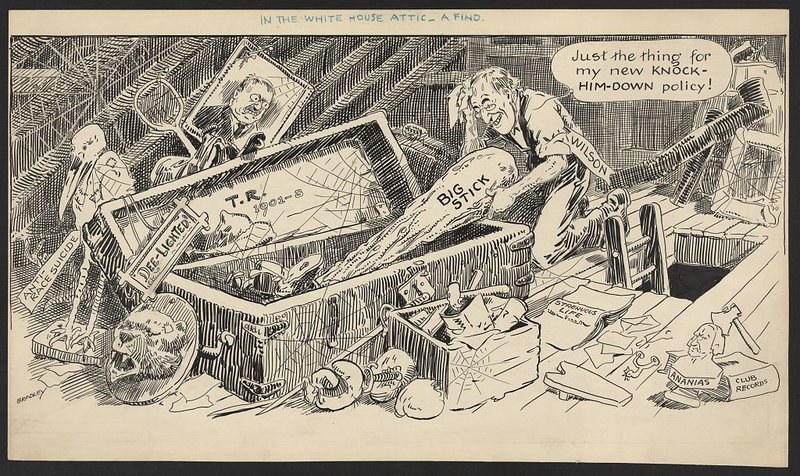
Going to War with the Army you Have, not the Army you Want
In late 2004, US Secretary of Defense Donald Rumsfeld was posed a series of questions from US troops in Kuwait including questions about their lack of preparedness for an entrenched conflict. Specialist Thomas Wilson (278th Regimental Combat Team, Tennessee National Guard) asked, “”Why do we soldiers have to dig through local landfills for pieces of scrap metal and compromised ballistic glass to uparmor [sic] our vehicles?” Rumsfeld replied, “As you know, you have to go to war with the Army you have, not the Army you want.”[6] Eighty-seven years earlier, the US found itself declaring to enter a war that it was not prepared to fight.
On April 2nd, 1917, Wilson asked for and shortly thereafter received a declaration of war against Germany –not Austria, the Ottoman Empire, or any of other two dozen or so countries that were fighting against the Allies. The Senate voted 82 to 6 to declare war on Germany on April 4, 1917; the House concurred on April 6 by a vote of 373 to 50. Jeannette Rankin of Montana, the first woman to serve in the House of Representatives, was among those who voted against the war. “I want to stand by my country, but I cannot vote for war,” declared Rankin. Later on, she clarified her decision to vote against going to war on the grounds that “I knew that we were asked to vote for a commercial war [and] that none of the idealistic hopes would be carried out.”
Over fifty members of the House agreed with Rankin, to include the Chairman of the House Ways and Means Committee, Claude Kitchin (D-NC). Kitchin rejected the call to war believing that those who will be called to fight and die will not be the ones who declared the war to begin with: “Let me once remind the House that it takes neither moral nor physical courage to declare a war for others to fight.” The US was simply not prepared to fight a protracted European conflict, which some Americans seem well aware of. The author of The Klansman (turned into the movie Birth of a Nation) wrote a sequel that was turned into a movie in 1916 called Fall of a Nation, portraying goose-stepping, spiked-helmet-sporting Germans marching over this country. The movie was a clear shot at US pacifists in general, and President Wilson in particular.
General Leonard Wood, a one-time US military commander of Cuba, was Wilson’s Chief of Staff until 1914. Wilson and Wood diverged on their interpretations of US preparation for war with the former fearing that preparing for war would necessarily lead to war and the latter a proponent of creating and maintaining a standing army as a matter of policy in general.
One immediate concern that Wilson tackled was the diversity of Americans (especially all those German immigrants). Thus, Wilson created the Committee on Public Information (CPI). Led by George Creel, the CPI was tasked with ensuring that American opinion favored US intervention and supported a possible protracted conflict. One thing the CPI did was to work with Hollywood and produce a series of huber-patriotic movies depicting clear and explicit differences between the liberty-loving Americans and the German animals, such as “The Claws of the Hun” and “The Kaiser: The Beast of Berlin”.
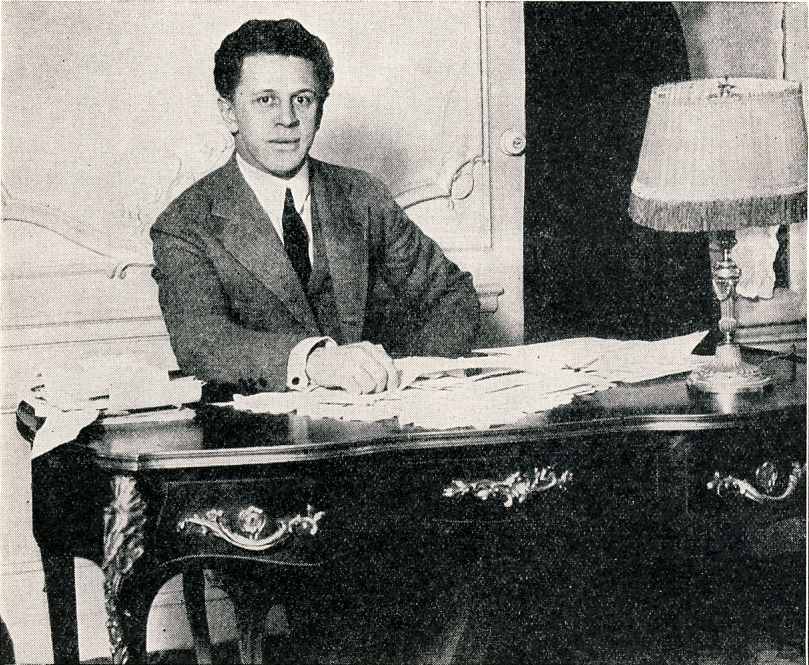
Creel created a pool of amateur speakers who were tasked with giving targeted speeches to specific ethnic crowds in support of the US war effort. These speakers were supposed to make their points in no more than four minutes and thus in an homage to the Revolution, Creel named these on-call speakers, “Four-Minute Men.” According to Creel, over 75,000 speakers gave an estimated 7.5 million speeches. Major ethnic groups such as Jews, Germans, and even American Indians were targeted to ensure their support for the war. Rabbi A.G. Robinson of New York reported that Jewish speakers reached “about 25,000 people per week. We expect soon to have every Jewish audience in a motion-picture house or a Jewish playhouse addressed by a Jewish playhouse addressed by a Jewish speaker.”
German-American communities were asked to take “The Pledge” (a pledge supporting the US against the Huns). Progressive era groups, such as the American Protective Association, targeted homes with German sounding names to ensure that there were no pictures of the Kaiser on their walls. American flags blossomed all over the country, like tulips and daffodils in the spring. A new group, the Boy Scouts of America, sold war bonds and collected money, rubber, and tin in support of the war effort. German groups and clubs were banned, closed, and at times burned by those liberty and justice-loving Americans.
Robert Prager, a German-born American refused to sign the Pledge. One evening members of the local “Council of Defense” (an ultrapatriotic group self-tasked with routing out all anti-American, as they defined anti-American, Americans) knocked on his front door. They gave him one final chance to sign the Pledge. When Prager refused someone in the crowd shouted “Get the rope!” According to Prager, “The first I knew was when the rope was about my neck and around my body under my arms.” He escaped being lynched.[7]
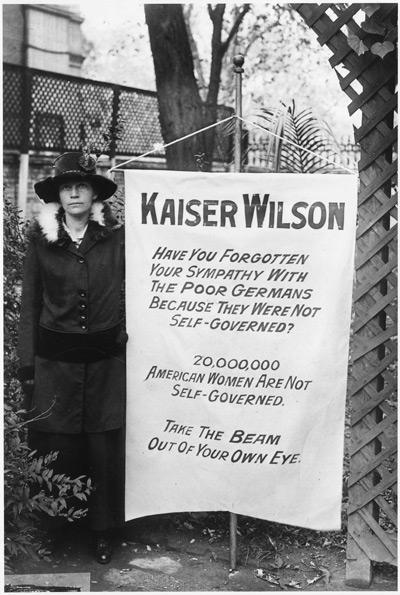
Women also joined in the preparation efforts. Women took jobs in US weapons factories (a precursor of things to come in the 1940s), they sold Liberty Bonds at church, school, and social functions; they led clothing drives for soldiers and immigrants; they ran canteens for American service men in England, and over 10,000 American women volunteered as Red Cross nurses in France. Women’s organizations put their work on the back burner in order to help in the total war effort. For example, the National American Women’s Suffrage Association (NAWSA) sponsored mobile field hospitals in France and England and urged their female workers and supporters to go to western Europe to staff those hospitals. NAWSA leaders were even concerned that Jeannette Rankin’s “no” vote would cast a pall on the organization because Rankin was a well-know member as well as an activist in the NAWSA. Yet, these were volunteer organizations and thus were not mandated by the federal government.
The Draft
Congress reluctantly passed the Selective Service Act on May 15th, 1917. Also known as the draft, this Act required all men between the ages of 18 and 30 to register with the federal government. The federal government also advertised. One poster, from the Tank Corps Recruiting Office in Washington, DC, took a rather tongue-in-cheek approach to attracting the attention of patriotic men:
Wanted: Husky Young Americans, College or University Training Desirable, Though Not Essential to Tour to Berlin Via France and No Man’s Land … :
Join the Tanks.[8]
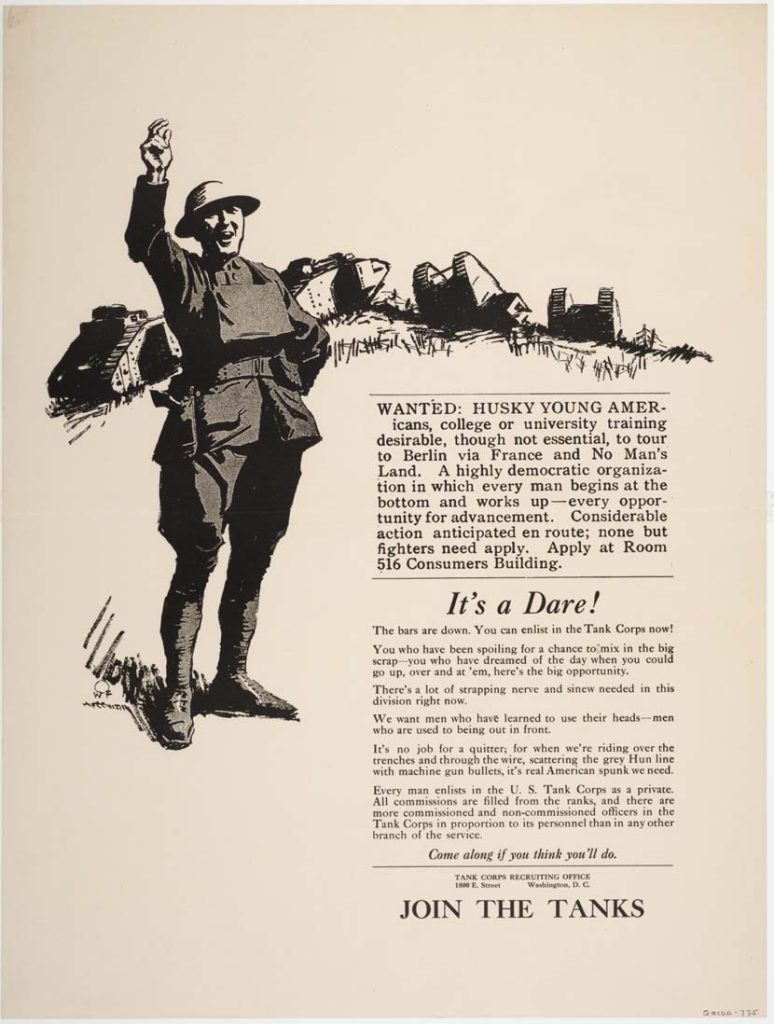
“Hello Girls”
The federal government needed thousands of people to work directly for the US Army in the Signal Corps or as civilian telephone operators presumably women to free up civilian male operators to enter the ranks of the Signal Corps. “Amateur wireless operators, women typists, and all other young men and women possessing the fundamentals of grammar and high school education” were urged to heed the call of the War Department. Western Union, the largest US telegraph company, was training 2,500 people to meet the domestic needs of the communication giant in order for the company’s more seasoned operators to join the war effort in early May of 1917.
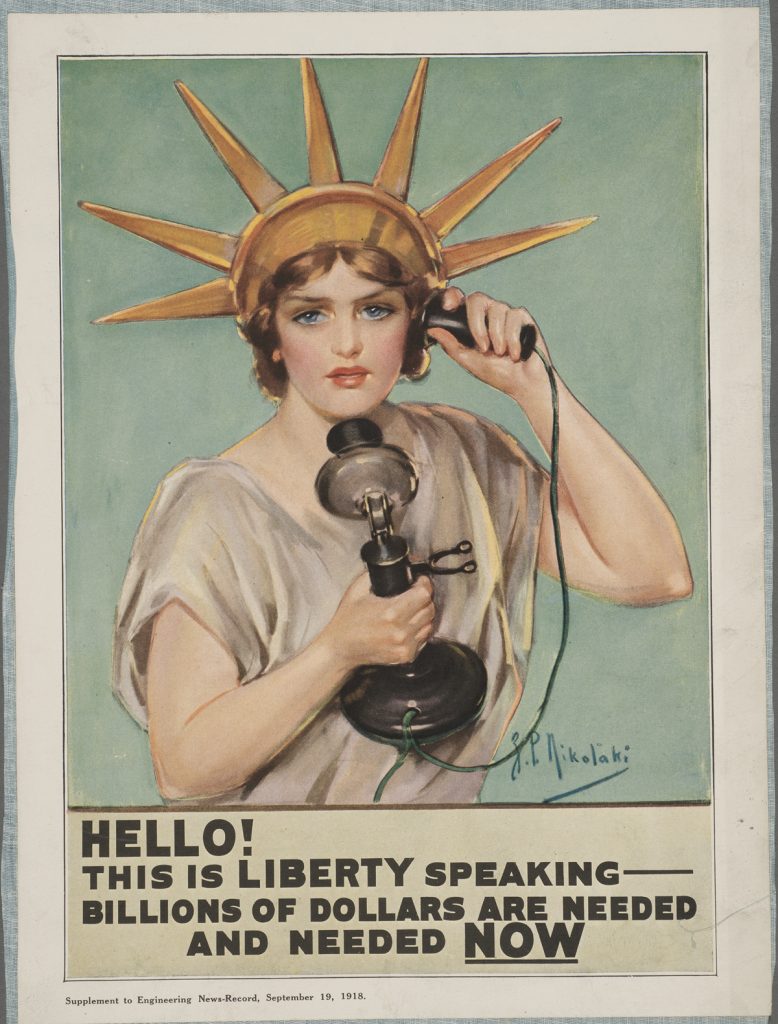
There were two jobs for women eager to serve in uniform: nurses and in the Signal Corps. Male members of the Signal Corps were stationed in the trenches, while female members performed communications duties primarily for the various US military headquarters in France such as the First Army, located in Verdun. Technically, women were not full members of the military and although they sported rank on their shoulders, they were not considered veterans. Not unlike women during other wars, the federal government was slow to recognize their work as sufficiently critical to the overall mission as to qualify these women as veterans. The US government did not bestow veteran status on the women of the US Army Signal Corps until towards the end of the Carter administration. To those who relied on their bravery, patriotism, and courage, the women of the US Army Signal Corps were known as “Hello Girls.”
The first group of women to join the ranks of the US Army had to be fluent in both English and French. Approximately 300 American women volunteered and after training that included self-defense (just in case their units were overrun by Germans) more than 75% of those original volunteers were sent to Europe with the rank of lieutenant (the same rank as female nurses). They were subject to the same military regulations (Court Martial) as their male counterparts, plus ten other rules supposedly to protect women’s virtue. Yet, those additional rules seem to have disappeared into the historical abyss, not unlike the details of the women who served this country as unequal citizens as American women did not enjoy universal suffrage, such as the nineteen-year-old Oleda Joure, from Marine City, Michigan. Of course, by the time Joure turned 21, the Nineteenth Amendment will be adopted and this veteran of the Great War will be allowed to vote.
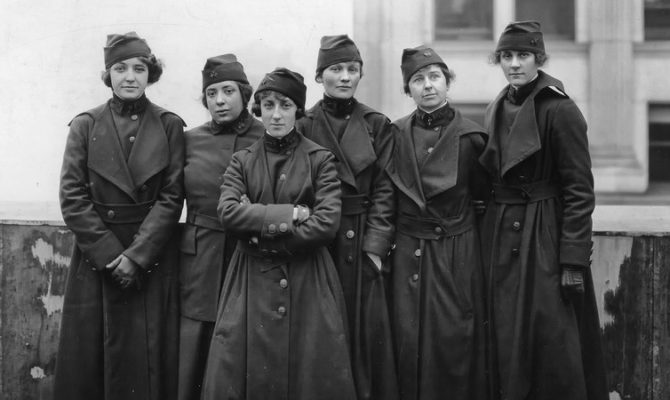
Most of these telephone operators were stationed with Pershing at Chaumont, but they also served throughout France and England. Distinctions were far and few between but one decorated woman Signal Corps volunteer was Grace Banker, the chief operator for the First Army headquarters. She received a Distinguished Service Medal for her wartime efforts. This was a new award, authorized by Congress in the summer of 1918, went “to persons other than members of the Armed Forces of the United States for wartime services only.” In other words, this was a medal for civilians only.
Shortly after the Armistice went into effect, nearly all of the women of the US Army Signal Corps were rotated back to the United States. In 1919, the chief of the Signal Corp reported that “[t]he use of women operators throughout the entire war was decidedly a success…”. Although the federal government will not act on their advise, the American Medical Association and the US Surgeon General, Major General William Gorgas supported granting military rank to women who served as doctors and surgeons “engaged in war work.”[9]
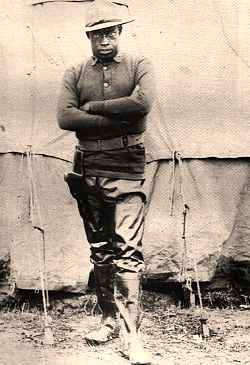
African Americans and the Great War
Over 400,000 African-Americans entered the ranks of the US military during World War I. As the US was a segregated society, so too was the military which consisted of all-white and all-black units. The latter included such famous and highly decorated units as the 369th Infantry known as the “Harlem Hell Fighters,” the 803rd Pioneer Infantry Band, No. 16, and the 370th Regiment, Illinois National Guard, to name a few. Most “all-black” units were under the control of white officers and such was the case of Col. William Hayward and the Harlem Hell Fighters. That unit was one of the most highly decorated US military units of the war. They were the first US unit to be awarded the French Croix de Guerre. Pershing “loaned” the 369th to France and thus this nearly-all-black unit saw some of the most brutal combat to include Chateau-Thierry and Belleau Wood where nearly 10,000 Allied troops were killed or wounded. They spent 191 days in the trenches (longer than any unit from either side) and they were the first allied unit to cross the Rhine.
Some of the 369th consisted of a popular band led by James Reese Europe. Europe was promoted to Lieutenant and this band leader was also the highest ranking black soldier in the unit.
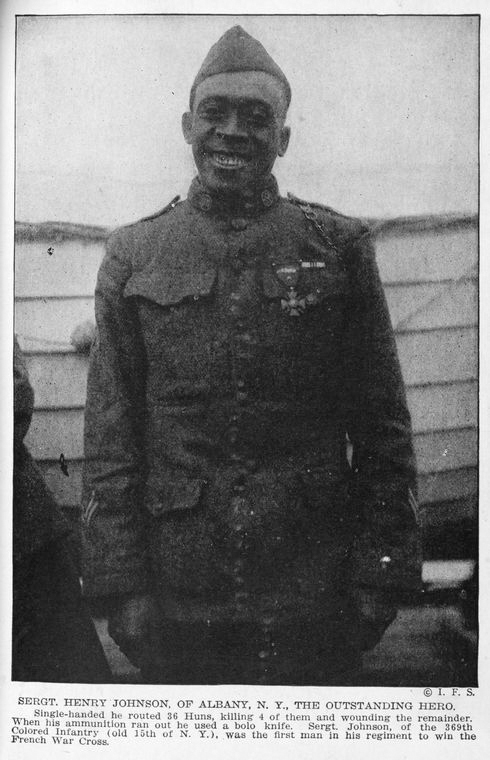
Henry Johnson was another member of the Harlem Hell Fighters. Johnson and Needham Roberts were performing watch duty when they were surprised by a German squad consisting of at least 14 men. The two Americans took sniper fire. Johnson and Roberts fired upon the Germans, but soon the German soldiers overwhelmed their position. Roberts was badly wounded in the initial attack. Johnson then engaged in hand-to-hand combat while also protecting Roberts. At first, Johnson used his rifle as a club. But then he noticed some Germans trying to take the wounded Roberts prisoner. Using a bolo knife, Johnson killed several Germans while taking gunfire and bayonet wounds. He was wounded 21 times in the melee. However Johnson fought off the Germans, who eventually retreated and saved his fellow soldier Roberts. He killed four Germans and wounded at least 10 of them. For his bravery Johnson was awarded the French Croix de Guerre avec Palme -France’s highest award.[10] Teddy Roosevelt called Johnson “one of the five bravest America soldiers in the war.”[11] The US government did not award Johnson with the Medal of Honor until 73 years after his death, when he was also awarded the Purple Heart.
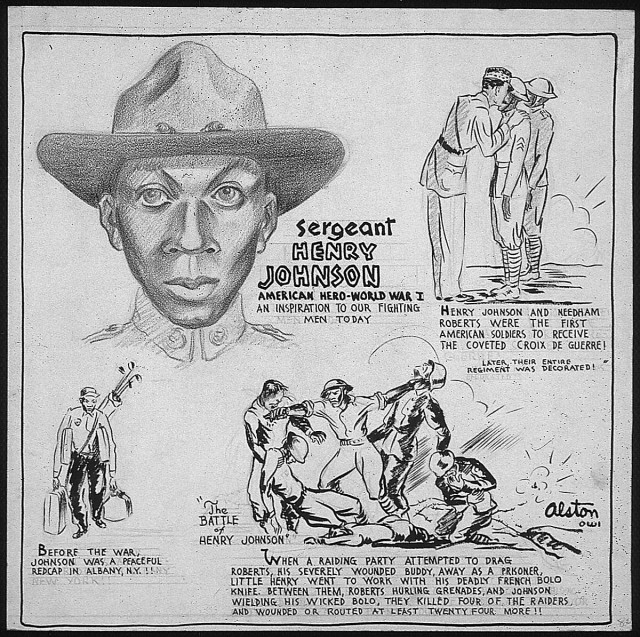
The federal government created a new officer training school in Iowa where over 1,000 African-American men received commissions as officers for the war. The country’s first black graduate of the US Military Academy West Point, Charles Young who saw combat in Cuba, the Philippines, Haiti and Mexico was not allowed to command troops in Europe.
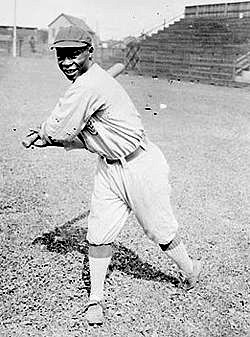
Many prominent African-Americans joined the military to include Napoleon Marshall, Spotswood Poles, and James Reese Europe. Poles was a well-known and very talented centerfielder for the New York Lincoln Giants (a Harlem-located baseball team in the Negro League). But Reese was probably the most nationally-known African-American. Reese was a Harlem bandleader and possibly the most popular song writer of the early twentieth century. His music inspired new dance steps, led to the creation of new night clubs, and almost single-handedly developed dancing as a popular form of entertainment among young people. In 1914, Europe’s orchestra (usually known as Europe’s Society Orchestra) became the first black band to record commercially in the United States. The orchestra’s benefactors, Vernon and Irene Castle, aligned the new dance steps in accordance with Europe’s syncopated music and thus social dancing was born. When the men of the 369th mustered out of the service in early 1919, Europe began writing and recording popular songs that capitalized on his war-time experiences. Songs such “On Patrol In No Man’s Land” evoked feelings of patriotism while under fire from a German mortar barrage
Europe will not live long enough to capitalize on his post-war fame. In early May of 1919, just days after Europe and his band completed a grueling recording session for Pathe Records, the group was playing a live performance in Boston when an argument developed between Europe and one of his drummers, Herbert Wright. Wright whipped out a knife and stabbed Europe in the neck. Europe died at the hospital. Newspapers reported the loss with the banner “Jazz King is Dead”. Reese was buried at Arlington National Cemetery.[12]
It is unclear why Reese enlisted in the New York National Guard. Maybe it was patriotism. Maybe he heard the call from such black leaders as W.E.B. Du Bois. Du Bois believed that blacks had a duty to serve in the military as a way of demonstrating their intelligence, bravery, and patriotism to white Americans. Thus, Du Bois publicly called upon African Americans to enlist, fight and if necessary lay down their lives for the United States. “If this is our country,” said Du Bois, “then this is our war. We must fight it with every ounce of blood and treasure.”
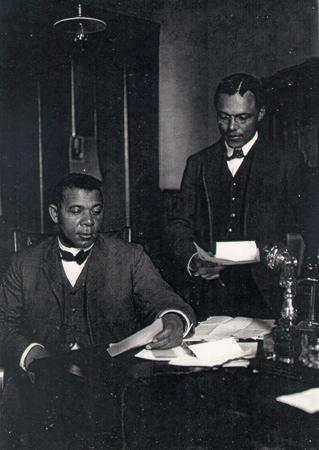
African-Americans also supported the war effort as civilians, such as Emmett J. Scott. Scott spent most of his career working for the NAACP, to include eighteen years as the private secretary of Booker T. Washington. When the US declared war on Germany, President Wilson wanted a spokesman for Black troops in the War Department and thus Scott became a special assistant to Newton Baker, the Secretary of War, overseeing the recruitment, training, and overall morale of Africa-American troops.
None of these actions or personalities curtailed Jim Crow. For example, African-American troops from California and Wyoming had been sent a training camp in Houston, Texas. White and Hispanic Houstonians were not terribly happy to see the influx of black people. Houston, like most southern cities, supported a system of codified racism to include preventing blacks from riding trolleys, eating at certain restaurants, and gathering in most public places.
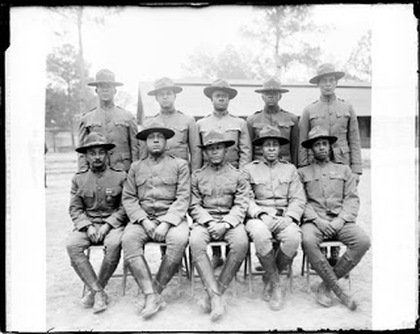
One hot, sticky August day a young African-American recruit tried to stop a Houston cop from beating an Africa-American woman. The cop, Lee Sparks, turned his club against the recruit, who was quickly dragged to jail. A non-commissioned officer named Charles Baltimore investigated the incident and for his troubles he too was arrested. While both troops were eventually released, an armed group of black troops launched an attack on the police station. In the ensuring melee, fifteen people died including five policemen and six blacks (four of whom were in the Army).
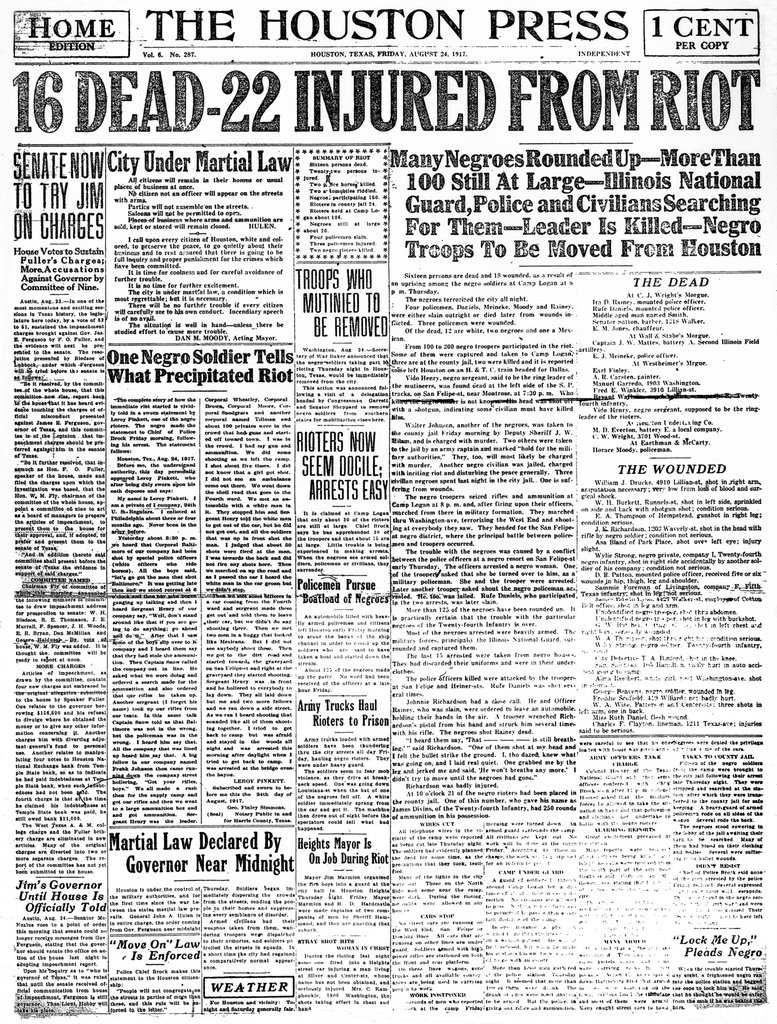
Sixty-three African-American troops will be arrested and charged with mutiny. At the first of several courts martial, thirteen African-American soldiers were found guilty and sentenced to death, including Corporal Baltimore. Seven more troops will be executed in the second trial, and dozens will be confined to jail raging from 24 months to life at the final court martial proceedings. Race riots were not limited to war-time America (New Orleans 1900, Atlanta 1902 and 1906, Springfield, IL 1908) yet their numbers and intensity increased between 1916 and 1923, especially evident when those tens of thousands of African-American troops started coming home from the war.
Sometimes Jim Crow was successfully challenged, even for the brief length of the US involvement in the war. For example, in Rocky Mount, North Carolina a white floor manager in a textile factory was accused by his black female workers of verbally abusing the women and so they walked off their jobs in protest. According to the Norfolk Journal and Guide, “[w]hen the superintendent learned of the trouble later in the day he immediately began to visit the homes of the operatives asking them to return to work. The offending white manager was discharged and the girls returned to their work with no loss of time.”[13]
Finally, the war resulted in a major wave of African-American migration from the South. Blacks were certainly living in northern towns before World War I, however the sheer number of factories in support of the war effort was a powerful pull factor. For example, Gary, Indiana and Detroit, Michigan experienced an increase in black populations between 1910 and 1920 – nearly 1300% and 611% respectively. New York City, which already had a well-established black population of over 90,000 in 1910, witnessed its black population increase by 66% by 1920.
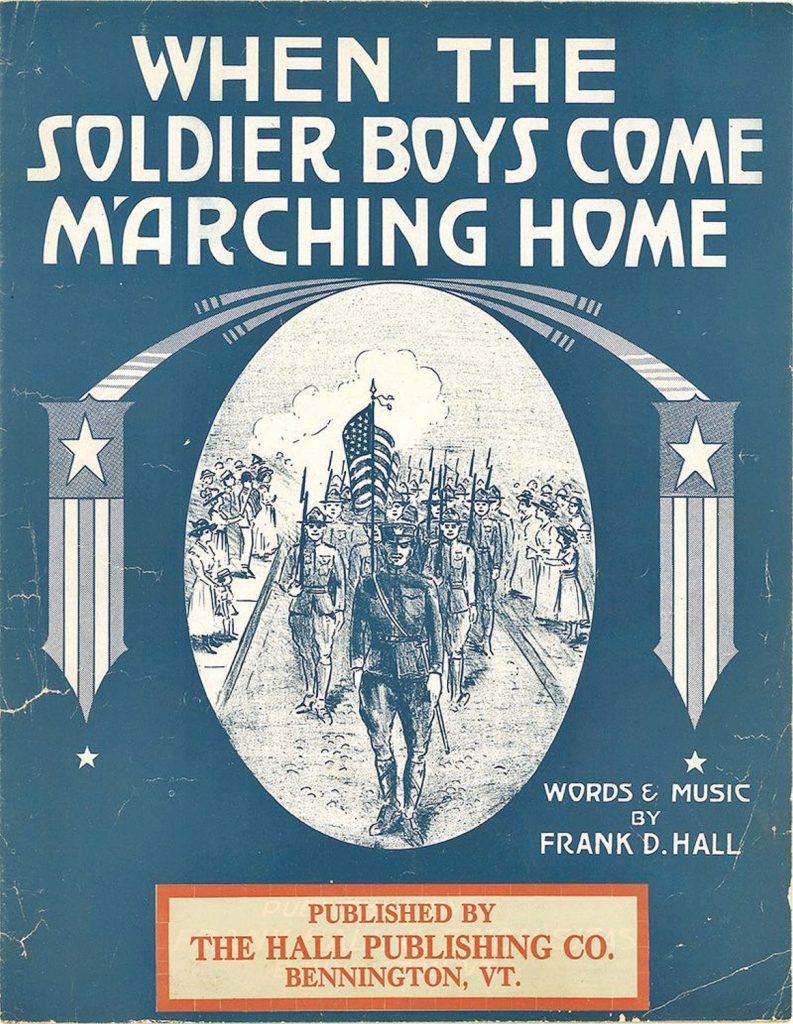
“Sammee! Sammee! Vive Sammee!”
In 1918, a Yankee of Irish roots named George M. Cohan penned a patriotic ditty that played all over this broad land when young men were asked by President Woodrow Wilson to drop their plow shears, leave their factory jobs, and enter the ranks of the US military to prevent Germany from running roughshod over Europe. Cohan grew up entertaining Americans.
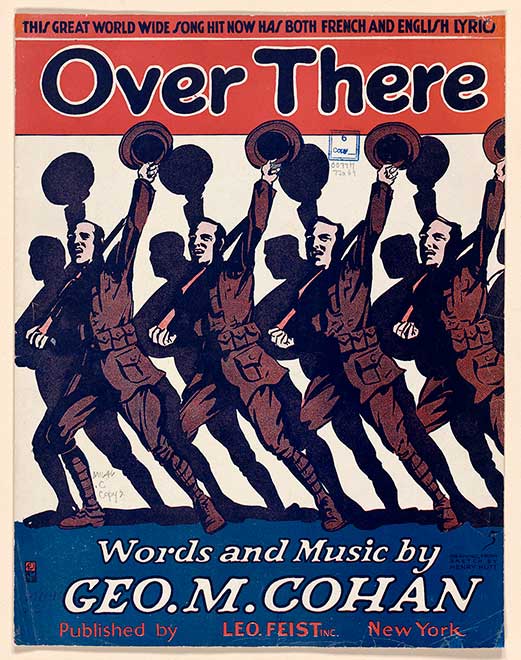
His family consisted of vaudeville performs during the Gilded Age but settled down in the early twentieth century, which allowed George to focus his energies on writing songs for his adopted town of New York, specifically for Broadway. On the eve of the US entry into World War II, Congress presented Cohan with a Congressional Medal of Honor in large measure for both his body of patriot work as well as the unofficial US anthem during the Great War, Over There that included the famous chorus:
Andrew Carp’s 1917 addition to patriotic war music I Have Come to Say Good-Bye includes specific reasons why the US is in the war to include fighting for freedom, in defense of American liberties, to make the world safe for democracy. Other songwriters such as William Hart and Eddie Nelson focused on the fringe benefits of serving overseas, such as in their 1918 song When Yankee Doodle Learns to Parlez Vous Francais: “He will call each girlie ‘Ma Cherie’, To every Miss that wants a kiss he’ll saw Wee, Wee On Ze Be, On Ze Bou, On Ze Boule, Boulevard, With a girl, with a curl, you can see him promenade When Yankee Doodle learns to Parlez vous Francais, ‘Oo La La, Sweet Papa’ he will teach them all to say.”
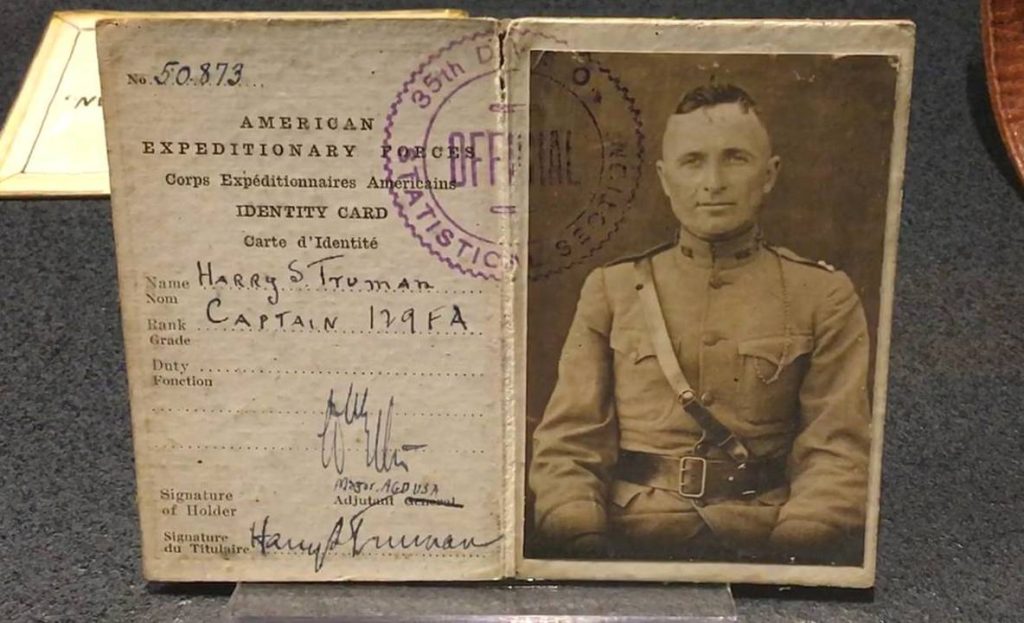
None of those reasons were evident in the letters written to Bess Wallace by her finance and officer in the US Army. In his first letter to Miss Wallace the thirty-four-year old Harry Truman gushed with pride over his recent military experience. I “fired five hundred rounds at the Germans . . . been shelled, didn’t run away . . . and never lost a man,” wrote Truman to Wallace on September 1st, 1918.
Truman sent numerous letters home, keeping his fiance up to date with the places where he fought, the people under his command, the fallibility of German soldiers as well as German bomb-making technology, and his hope that Bess will keep writing. “Please keep on writing because it helps put the pep into me,” he told her in early October. He also became more personal as the battles waged on. Truman arrived back in the US in early spring of 1919. Less than two months later the Trumans were married. They settled in Kansas City where Harry opened up a haberdashery with his Army buddy, Eddie Jacobson. Harry will die the day after Christmas in 1972. His wife, Bess, will live another decade, dying in 1982 at the age of 97.
American troops were known by many names, to include the pejorative “doughboy.” There are many theories as to how and when this term entered the American lexicon. Some historians believe the word is based in the US Civil War. Union officers, from the vantage point of their horses, looked down upon rows of Northern troops whose headgear suggested rising muffins or small loaves of yeast rolls. Others argue that “doughboy” was a synonym only for a soldier, not Marines or members of the US Navy.
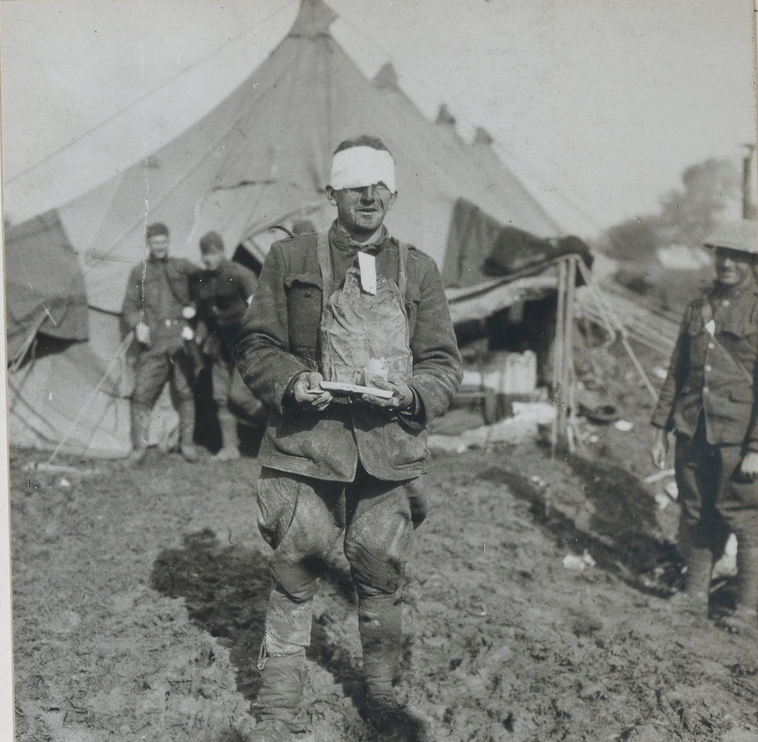
Yet, when American troops officially began arriving under the command and control of Pershing, French citizens shouted their support for the “Sammees.” A line from a 1917 song with the geographically challenged title I Don’t Know where I’m Going, But I’m On My Way included the line “Uncle Sammy is calling me so I must go.” On July 2nd, 1917, Wythe Williams, a reporter for the New York Times noted this shift in terminology: “The ‘Sammees’ are American regulars,” reported Williams, “no longer are they ‘doughboys.’” Williams predicted that “Sammee” will one day be as synonymous with US soldiers as “Tommy” is for British troops or “Poilu” (“poilus” is the plural) for French fighters. Lazare Ponticelli, the last poilu of the trenches died in early March of 2008 at the age of 110. The last surviving Tommy to see combat in the trenches is Henry John Patch, who was born June 17, 1898.
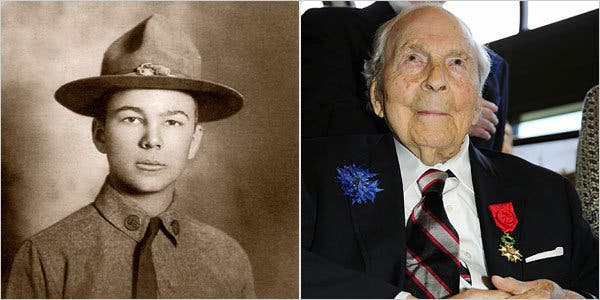
One Sammee was named Frank Woodruff Buckles. He was born in rural Missouri in 1901. Sixteen years later he tried to enlist in the military. Buckles had dreamed of serving his country since he was a young boy. “When I was 12 or 13, I slept on the floor” to prepare for a soldier’s life, he said. Initially, Buckles tried to enlist in the Marines. He visited a recruiting booth at the Kansas state fair in 1917. “I said that I was 18, but the understanding sergeant said that I was too young. I had to be 21.”[14] He returned to the recruiting booth and was rejected by another Marine recruiter. Determined to serve his country, he traveled to a Navy recruiting office in Oklahoma, where he was promptly denied enlistment. He tried enlisting in the Marines once more time before coming across an Army recruiter who did not press the age issue. Besides, said Buckles, he told the Army recruiter that his small town did not keep birth records and so the recruiter allowed the fifteen-year-old to enlist, believing he was eighteen. On August 14th, 1917, Buckles joined the US Army.[15]
He drove ambulances and worked in various administration positions in England and France. He returned to the US on board the USS Pocahontas in late 1919 and was discharged by January of 1920 after serving in a unit escorting German prisoners back to Germany. Buckles had $114 in his pocket and escaped all injury. As of February of 2009, Buckles is the last living US veteran of the Great War at the age of 107.[16]
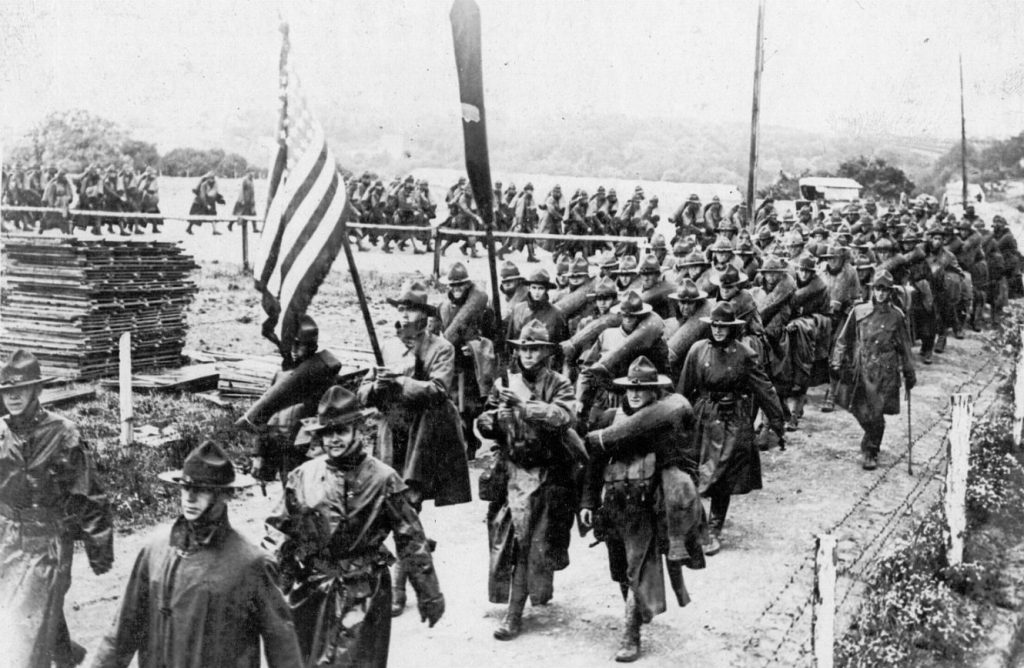
Very little was known a bout the arrival of the first American troops except that their supplies included plenty of tobacco. “The American censor was the first man on the job,” Wythe Williams reported. “Sammee! Sammee! Vive Samme!” shouted the French crowd as the first Americans arrived.
Known as the American Expeditionary Force (AEF), some five million men and women entered the ranks of the US military with a little over two million being sent to Europe under the command and control of Pershing and the AEF.
Although Americans fought under British and French control for years (such as the American pilots who flew with the French military, to include Eugene Bullard), the first official battle that Americans participated as the AEF was the battle of Chateau-Thierry when approximately 70,000 US troops (to include all-black military units under French control and US Marines under Pershing’s control) helped stop a German thrust. AEF and French troops then launched a counter-offensive, driving back German forces. With at least 250,000 American troops and a massive amount of military equipment entering English ports each month, the war was quickly coming to an end. In the early fall of 1918, Pershing and the AEF took control of the southern front.
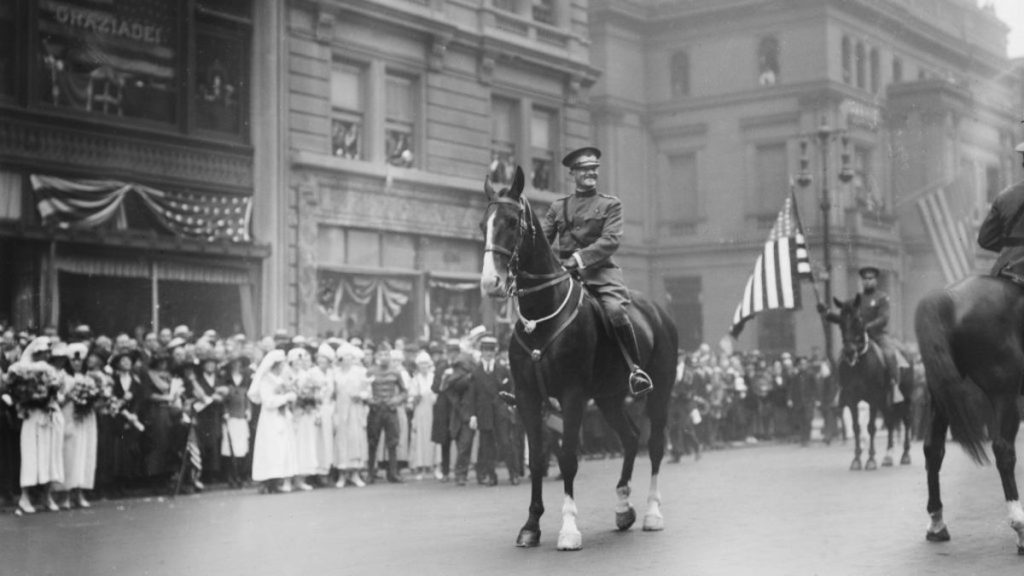
The war came to an end on November 11th, 1918 at 11am. Although over 200,000 Americans were wounded and 113,000 troops died (around 52,000 in battle and 60,000 from non-combat issues such as disease), the relative short nature of the US role in the war saved the United States from experiencing the horror of trench warfare and the massive loss of lives which were the reality for Russian, German, French, and English people.
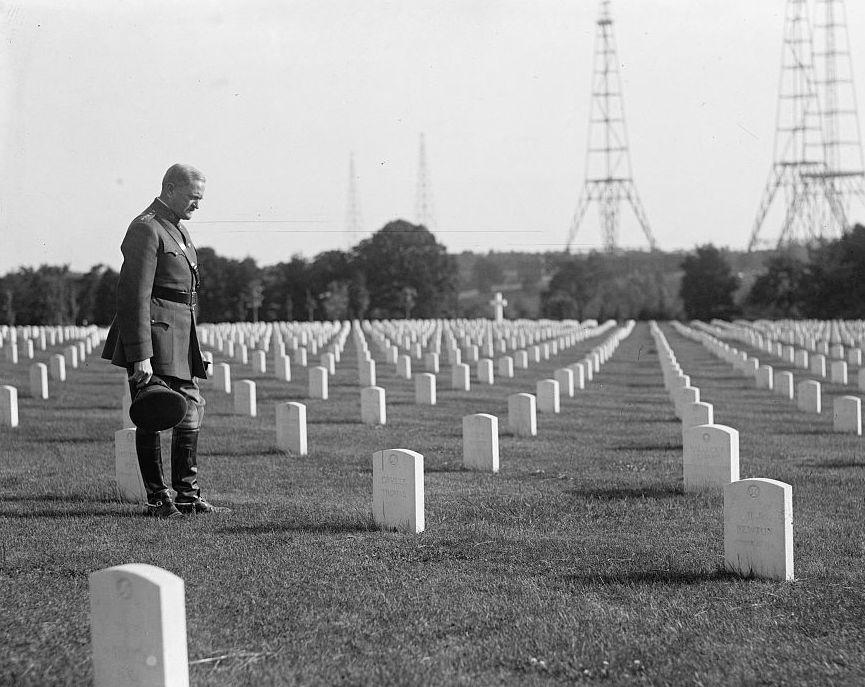
Military and civilian deaths for Great Britain topped one million, 1.7 million for France, 2.3 million for Russia, and 2.5 million for Germany. About 500,000 people were killed or wounded during the First Battle of Marne (1914), 230,000 at the Battle of Ypres (1914), and 700,000 at Verdun (1916). The massive destruction of human life would not be experienced by the United States, until the troops began returning home. Nevertheless, Americans will remain in Germany, as an occupying force, until 1926, when Germany is allowed to join the League of Nations.
(End of Part I)
As with the other chapters, I have no doubt that this chapter contains inaccuracies therefore, please point them out to me so that I may make this chapter better. Also, I am looking for contributors so if you are interested in adding anything at all, please contact me at james.rossnazzal@hccs.edu.
- See Craig Lloyd's book Eugene Bullard, Black Expatriate in Jazz-Age Paris. ↵
- Various sources to include https://uh.edu/engines/epi997.htm ↵
- Information in this from my notes from various books to include All Blood Runs Red by Phil Keith; Eugene Bullard: Black Expatriate in the Jazz Age by Craig Lloyd and Eugene Bullard: World's First Black Pilot by Larry Greenly. ↵
- http://www.digitalhistory.uh.edu/teachers/lesson_plans/pdfs/unit8_9.pdf ↵
- https://www.ourdocuments.gov/print_friendly.php?flash=false&page=transcript&doc=60&title=Transcript+of+Zimmermann+Telegram+%281917%29 ↵
- https://www.nationalreview.com/corner/sorry-senator-you-dont-pick-secdef-kathryn-jean-lopez/amp/ ↵
- http://historymatters.gmu.edu/d/1/ ↵
- https://docsouth.unc.edu/wwi/41935/menu.html ↵
- American Women in World War I: They Also Served by Lettie Gavin ↵
- https://www.smithsonianmag.com/history/remembering-henry-johnson-the-soldier-called-black-death-117386701/ ↵
- https://www.army.mil/medalofhonor/johnson/ ↵
- Multiple sources to include "A Study in Jazz Historiography: The New Grove Dictionary of Jazz" by Eileen Southern, College Music Symposium, Vol. 29 (1989), pp. 123-133. ↵
- http://historymatters.gmu.edu/d/5054/ ↵
- https://archive.defense.gov/news/newsarticle.aspx?id=49215 ↵
- https://www.smithsonianmag.com/history/the-last-doughboy-of-world-war-i-11880886/ ↵
- Ibid. ↵
